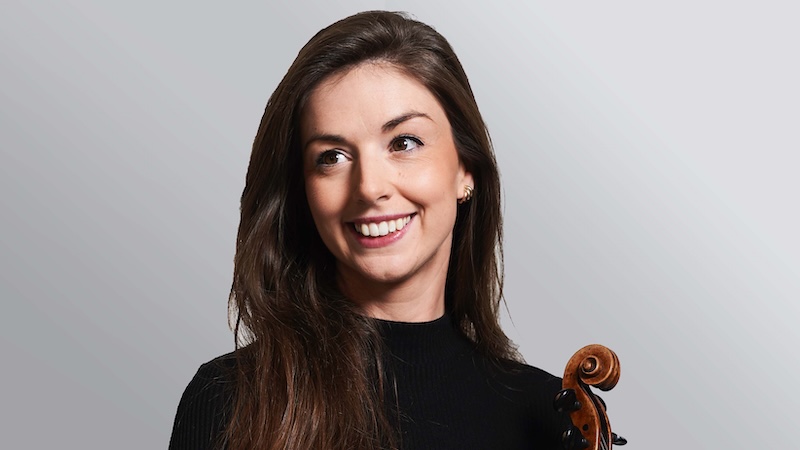Siglo de Oro, Wigmore Hall review - electronic Lamentations and Trojan tragedy | reviews, news & interviews
Siglo de Oro, Wigmore Hall review - electronic Lamentations and Trojan tragedy
Siglo de Oro, Wigmore Hall review - electronic Lamentations and Trojan tragedy
Committed and intense performance of a newly-commissioned oratorio

Siglo de Oro are a vocal ensemble who specialise in older music – and especially neglected older music – but they have also always programmed new music, and the centrepiece of this recital at the Wigmore Hall was a large-scale commission by composer Ben Rowarth, to words by Sophia Carr-Gomm.
The first half, though, was more familiar Siglo de Oro territory, starting with some trademark Hildegard, sung from the back of the hall, the unison line passed between solo voices and small groups, from downstairs to up in the gallery. This was followed by a Bach violin solo movement, beautifully played by Amy Tress (pictured below), with poise and a wonderful line.
The Palestrina Lamentations of 1588 are – to my modern ears – too serene and perfect to fully depict the misery of Jeremiah, but Jonathan Harvey had a solution, in his re-working of Palestrina’s Stabat Mater (2004). Here the original Palestrina, sung from the stage, is combined with a pre-recorded version in another key and live manipulations of the voices on stage. This certainly adds a piquancy to the basic Palestrina, with polytonal scrunches souring the consonance, and the resonance of the electronics putting us temporarily into a larger space. But I wondered whether, however well sung, this gilding of the lily got caught between being on the one hand too faithful (there are no compositional additions or alterations of the original) and too far from Palestrina’s own world. I also suffered from being too close to a speaker, so got an unbalanced sound, something I was glad to put right by moving a few rows for the second half. And here Ben Rowarth’s The Fall achieved a real sense of lament and an emotional drawing-in that I found more affecting than the Harvey/Palestrina. It is a telling of the story of the Trojan War through the eyes of Cassandra, but the fragmented text and the deliberately oblique word-make it possible to enjoy the piece without really knowing what it was about. For me, its pleasures lay in the subtle textures, the 12 voices whispering, muttering, chanting, droning, interacting with the live violin, and the electronically distorted pre-recorded violin.
And here Ben Rowarth’s The Fall achieved a real sense of lament and an emotional drawing-in that I found more affecting than the Harvey/Palestrina. It is a telling of the story of the Trojan War through the eyes of Cassandra, but the fragmented text and the deliberately oblique word-make it possible to enjoy the piece without really knowing what it was about. For me, its pleasures lay in the subtle textures, the 12 voices whispering, muttering, chanting, droning, interacting with the live violin, and the electronically distorted pre-recorded violin.
The text is jittery in its repetitions and mantras and Rowarth has responded to Gomm-Carr’s eminently settable words with a seriousness of intent, and the skill to sustain a large-scale conception. The singers are mostly quiet, making the occasional outbursts hit home all the more effectively. It is a proper ensemble piece, with only one solo spot, for the alto Rebekah Nießer-Jones, a folky meditation gradually overwhelmed by other sounds. Meanwhile, the still centre of everything was Amy Tress, her violin keening and sliding, or inexorably plucking, dancing around the choir. And credit for the whole ambitious project must go to conductor and artistic director Patrick Allies, who led a most committed and intense performance.
rating
Explore topics
Share this article
The future of Arts Journalism
You can stop theartsdesk.com closing!
We urgently need financing to survive. Our fundraising drive has thus far raised £49,000 but we need to reach £100,000 or we will be forced to close. Please contribute here: https://gofund.me/c3f6033d
And if you can forward this information to anyone who might assist, we’d be grateful.

Subscribe to theartsdesk.com
Thank you for continuing to read our work on theartsdesk.com. For unlimited access to every article in its entirety, including our archive of more than 15,000 pieces, we're asking for £5 per month or £40 per year. We feel it's a very good deal, and hope you do too.
To take a subscription now simply click here.
And if you're looking for that extra gift for a friend or family member, why not treat them to a theartsdesk.com gift subscription?
more Classical music
 BBC Proms: Barruk, Norwegian Chamber Orchestra, Kuusisto review - vague incantations, precise laments
First-half mix of Sámi songs and string things falters, but Shostakovich scours the soul
BBC Proms: Barruk, Norwegian Chamber Orchestra, Kuusisto review - vague incantations, precise laments
First-half mix of Sámi songs and string things falters, but Shostakovich scours the soul
 BBC Proms: Alexander’s Feast, Irish Baroque Orchestra, Whelan review - rapturous Handel fills the space
Pure joy, with a touch of introspection, from a great ensemble and three superb soloists
BBC Proms: Alexander’s Feast, Irish Baroque Orchestra, Whelan review - rapturous Handel fills the space
Pure joy, with a touch of introspection, from a great ensemble and three superb soloists
 BBC Proms: Moore, LSO, Bancroft review - the freshness of morning wind and brass
English concert band music...and an outlier
BBC Proms: Moore, LSO, Bancroft review - the freshness of morning wind and brass
English concert band music...and an outlier
 Willis-Sørensen, Ukrainian Freedom Orchestra, Wilson, Cadogan Hall review - romantic resilience
Passion, and polish, from Kyiv's musical warriors
Willis-Sørensen, Ukrainian Freedom Orchestra, Wilson, Cadogan Hall review - romantic resilience
Passion, and polish, from Kyiv's musical warriors
 BBC Proms: Faust, Gewandhausorchester Leipzig, Nelsons review - grace, then grandeur
A great fiddler lightens a dense orchestral palette
BBC Proms: Faust, Gewandhausorchester Leipzig, Nelsons review - grace, then grandeur
A great fiddler lightens a dense orchestral palette
 BBC Proms: Jansen, Royal Concertgebouw Orchestra, Mäkelä review - confirming a phenomenon
Second Prom of a great orchestra and chief conductor in waiting never puts a foot wrong
BBC Proms: Jansen, Royal Concertgebouw Orchestra, Mäkelä review - confirming a phenomenon
Second Prom of a great orchestra and chief conductor in waiting never puts a foot wrong
 BBC Proms: Royal Concertgebouw Orchestra, Mäkelä review - defiantly introverted Mahler 5 gives food for thought
Chief Conductor in Waiting has supple, nuanced chemistry with a great orchestra
BBC Proms: Royal Concertgebouw Orchestra, Mäkelä review - defiantly introverted Mahler 5 gives food for thought
Chief Conductor in Waiting has supple, nuanced chemistry with a great orchestra
 Dunedin Consort, Butt / D’Angelo, Muñoz, Edinburgh International Festival 2025 review - tedious Handel, directionless song recital
Ho-hum 'comic' cantata, and a song recital needing more than a beautiful voice
Dunedin Consort, Butt / D’Angelo, Muñoz, Edinburgh International Festival 2025 review - tedious Handel, directionless song recital
Ho-hum 'comic' cantata, and a song recital needing more than a beautiful voice
 Classical CDs: Dungeons, microtones and psychic distress
This year's big anniversary celebrated with a pair of boxes, plus clarinets, pianos and sacred music
Classical CDs: Dungeons, microtones and psychic distress
This year's big anniversary celebrated with a pair of boxes, plus clarinets, pianos and sacred music
 BBC Proms: Liu, Philharmonia, Rouvali review - fine-tuned Tchaikovsky epic
Sounds perfectly finessed in a colourful cornucopia
BBC Proms: Liu, Philharmonia, Rouvali review - fine-tuned Tchaikovsky epic
Sounds perfectly finessed in a colourful cornucopia
 BBC Proms: Suor Angelica, LSO, Pappano review - earthly passion, heavenly grief
A Sister to remember blesses Puccini's convent tragedy
BBC Proms: Suor Angelica, LSO, Pappano review - earthly passion, heavenly grief
A Sister to remember blesses Puccini's convent tragedy
 BBC Proms: A Mass of Life, BBCSO, Elder review - a subtle guide to Delius's Nietzschean masterpiece
Mark Elder held back from blasting the audience with a wall of sound
BBC Proms: A Mass of Life, BBCSO, Elder review - a subtle guide to Delius's Nietzschean masterpiece
Mark Elder held back from blasting the audience with a wall of sound

Add comment